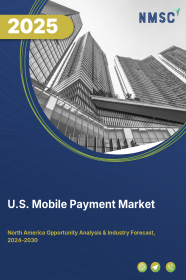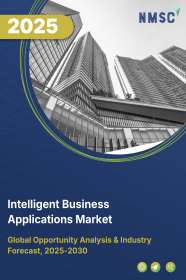
The U.S. Mobile Payment Market by Age (Generation Z, Millennials, Generation X, and Baby Boomers), by Payment Type (Proximity and Remote), and by Application (Money Transfers, Merchandise Purchases, Bill Payments, Airtime Top-ups, Ticketing, and Others) – Opportunity Analysis and Industry Forecast, 2024–2030
Industry: ICT & Media | Publish Date: 06-Jan-2025 | No of Pages: 111 | No. of Tables: 79 | No. of Figures: 44 | Format: PDF | Report Code : IC2471
US Tariff Impact on U.S. Mobile Payment Market
Trump Tariffs Are Reshaping Global Business
U.S. Mobile Payment Market Overview
The U.S. Mobile Payment Market size was valued at USD 6.26 billion in 2023, and is predicted to reach USD 21.26 billion by 2030, with a CAGR of 18.0% from 2024 to 2030. The mobile payment system, also known as money transfer, mobile money, m-payments, electronic payments, and digital payments, enables financial transactions through mobile devices such as smartphones, tablets, and wearables. These transactions occur through mobile apps or various methods such as proximity and remote transactions. Mobile payment systems include various types such as mobile wallets, mobile banking apps, and online payment services such as PayPal, Venmo, and Google Pay.
Utilizing technologies such as SMS, near-field communication (NFC), quick response (QR) codes, and others, these systems ensure smooth transactions while employing robust security measures including encryption and biometric authentication to protect personal and financial data. Praised for their convenience, speed, security, and integration with other financial tools, mobile payment systems experience widespread adoption. Additionally, users can configure payment apps to automatically settle bills, such as utility or credit card bills, ensuring efficient financial management and preventing late payments.
Rising Fintech and Digital Banking Services Propels the U.S. Mobile Payment Market
The rise of fintech and digital banking significantly drives the U.S. mobile payment market demand. Fintech innovations and digital banking services provide efficient financial solutions accessible via mobile devices, democratizing financial services. Consumers can conveniently manage their finances, make payments, and conduct transactions from their smartphones.
Integration of mobile payment features within fintech apps and digital banking platforms enhances user experience with seamless access to payment options and account management. Fintech firms and digital banks often lead innovation in payment technologies such as peer-to-peer transfers and contactless payments, driving adoption and shaping industry standards. As consumers increasingly adopt fintech and digital banking, the mobile payment market expands, offering greater choice and accessibility in the digital economy.
Ease of Use in Mobile Payment Services Drives the Market
Ease of use is a pivotal driver in the mobile payment market, ensuring platforms are accessible and user-friendly. Simplified interfaces, quick transactions, and robust security features build trust and encourage adoption among consumers and merchants alike. Clear support and education enhance user confidence, ensuring a positive experience and fostering the U.S. mobile payment market growth.
Risks Related to Data Breaches and Security Concerns Hamper the U.S. Mobile Payment Market Growth
Risks related to data breaches and security concerns present significant obstacles to the U.S. mobile payment market growth. With the increasing reliance on mobile devices for financial transactions, the potential for unauthorized access, data breaches, and identity theft has become a major worry for consumers and businesses. Instances of high-profile security incidents can undermine trust in mobile payment platforms, leading users to hesitate in adopting or continuing to use mobile payment services.
Additionally, regulatory bodies impose stringent requirements for data protection and cybersecurity, which add complexity and costs to mobile payment operations. Mitigating these security concerns necessitates implementing robust encryption, multi-factor authentication, and cybersecurity measures to build confidence in mobile payment solutions and drive market growth.
The Emergence of Real-Time Payment Creates Opportunities in the U.S. Mobile Payment Market
Real-time payments have emerged as a transformative force in the mobile payment market, presenting significant opportunities for growth and innovation in the country. These systems enable instantaneous fund transfers between parties, providing seamless and efficient payment experiences.
This advancement empowers mobile payment providers to cater to diverse needs, whether it's splitting bills with friends, making retail purchases, or transferring funds between accounts. Moreover, the integration of real-time payment capabilities into various sectors, such as e-commerce, peer-to-peer lending, and on-demand services, fosters innovation and expands the mobile payment ecosystem. In summary, the emergence of real-time payments revolutionizes payment processing and creates fertile ground for growth and innovation in the U.S. mobile payment market.
Competitive Landscape
Various market players operating in the U.S. mobile payment industry include Alphabet, Inc. (Google), Alibaba Group Holdings Limited, Amazon.com, Inc., Apple, Inc., PayPal Holdings, Inc., Visa, Inc., Tencent Holdings Limited (WeChat), MasterCard International, Inc., Samsung Electronics Co. Ltd., Block, Inc., and others. These key players have adopted various strategies to strengthen their market share.
U.S. Mobile Payment Market Key Segments
By Age
-
Generation Z
-
Millennials
-
Generation X
-
Baby Boomers
By Payment Type
-
Proximity
-
Near-Field Communication (NFC)
-
Quick Response (QR) Code Payments
-
-
Remote
-
Internet Payments
-
SMS/Direct Carrier Billing
-
By Application
-
Money Transfers
-
Merchandise Purchases
-
Bill Payments
-
Airtime Top-ups
-
Ticketing
-
Others
REPORT SCOPE AND SEGMENTATION:
|
Parameters |
Details |
|
Market Size in 2023 |
USD 6.26 Billion |
|
Revenue Forecast in 2030 |
USD 21.26 Billion |
|
Growth Rate |
CAGR of 18.0% from 2024 to 2030 |
|
Analysis Period |
2023–2030 |
|
Base Year Considered |
2023 |
|
Forecast Period |
2024–2030 |
|
Market Size Estimation |
Billion (USD) |
|
Growth Factors |
|
|
Companies Profiled |
10 |
|
Market Share |
Available for 10 companies |
|
Customization Scope |
Free customization (equivalent up to 80 working hours of analysts) after purchase. Addition or alteration to country, regional, and segment scope. |
|
Pricing and Purchase Options |
Avail customized purchase options to meet your exact research needs. |
KEY PLAYERS
-
Alphabet, Inc. (Google)
-
Alibaba Group Holdings Limited
-
Amazon.com, Inc.
-
Apple, Inc.
-
PayPal Holdings, Inc.
-
Visa, Inc.
-
Tencent Holdings Limited (WeChat)
-
MasterCard International, Inc.
-
Samsung Electronics Co. Ltd.
-
Block, Inc.

















 Speak to Our Analyst
Speak to Our Analyst





















